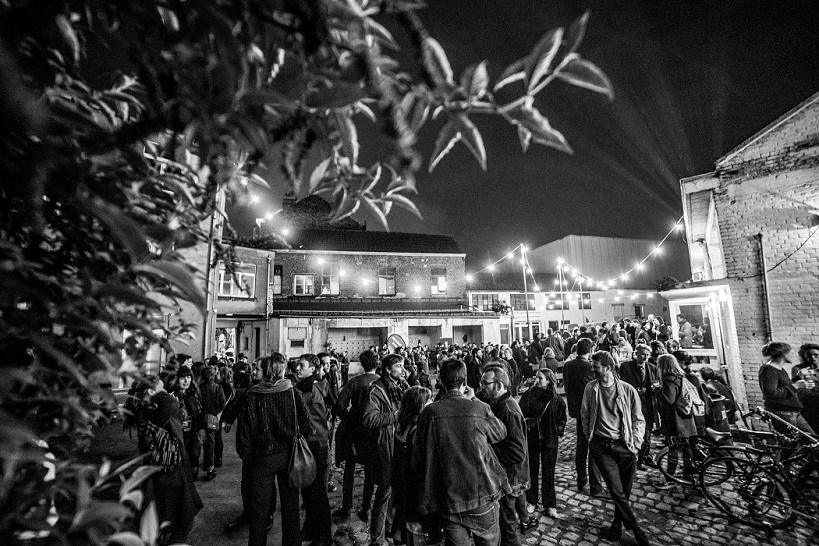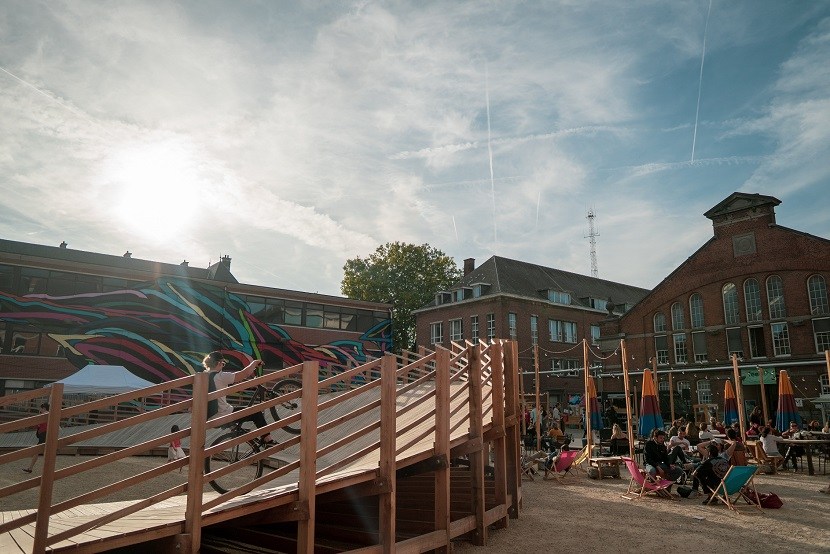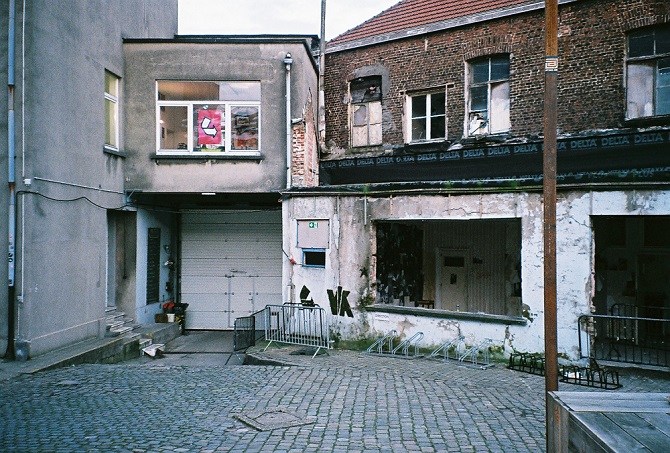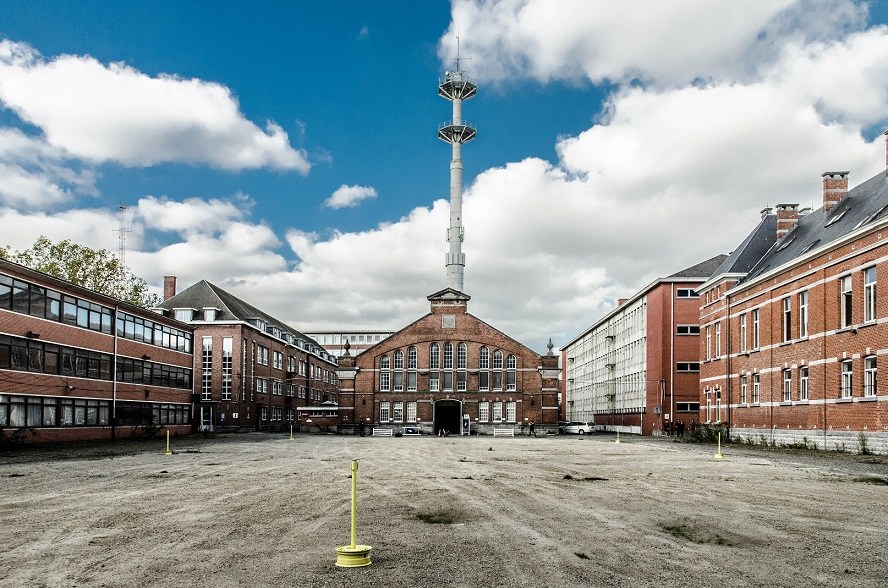Ungoverned and ubiquitous, the 20th municipality of Brussels sprawls unnoticed throughout the capital region’s territory.
Put together, its desolate lofts, vacant townhouses, deserted train stations, and forlorn industrial complexes and office buildings would cover a territory equivalent to that of Ixelles, and over twice the size of Saint-Gilles.
Yet no one lives there.
Despite its estimated 6.8 million square-metres of vacant space, Saint-Vide-Leegbeek’s population count remains stubbornly the same since its imaginary conception: zero.
Admittedly, for its founders, the goal of creating this fictitious municipality — whose name is a mix of words meaning ‘empty’ in French and Dutch, topped up with the prefix ‘Saint’ in a final touch of sanctified derision — was never to usher it into a politico-administrative reality. But, rather, to see it gradually fade away.
“By shedding a light on Brussels’ empty spaces, the region’s 20th municipality seeks to bring together different players to ensure that these spaces can be enjoyed by all members of the community,” the founders wrote on their website.
To do so, a collective of six cultural and urbanism non-profits is touting the use of an urbanistic tool whose growing popularity has brought a host of dormant properties out from a grey state of neglect and dilapidation and plugged them right back into Brussels’ bustling social and cultural scene — recently tipped as the emerging epicentre of contemporary art in Europe.
Known as temporary occupation contracts or permits, these schemes are akin to the unauthorised occupation of vacant properties, or building squatting.
Frowned upon and illegal, squats have been in the crosshairs of authorities in Brussels, who, from wealthy Uccle to poorer Saint-Josse, jumped on the approval of a 2017 federal anti-squatting law to wipe out what Uccle's mayor referred to as “outlaw areas”.
But at the same time as officials across Brussels cracked down on squats, temporary occupation contracts have emerged as their legalised counterparts, offering the double advantage of addressing a long-neglected issue (the staggering amount of unused properties in Brussels) and creating value for stakeholders.
“Instead of blindly fighting against them, authorities have today understood the added value that they could draw from certain ‘squats’”, Perspective Brussels, an agency spearheading urban development strategies at Brussels’ regional level, wrote in an overview of the scheme’s growing popularity.
As squatting was co-opted from the alternative and outcast spheres of Brussels, and pruned and moulded into an increasingly prevalent tool for urban renewal policies, temporary occupation contracts have encountered an “undeniable success” with all kinds of property owners and developers. They have become a new way of reactivating downbeat locations, some of which sit unused while permits are rolled out for lengthy urban redevelopment projects.
“Organisations have not only begun tolerating the presence of squats in their properties but have even proactively searched them out, notably by putting out calls for tenders,” the agency wrote.
In Brussels, the Regional Development Agency, CityDev, and other regional offices have facilitated the signing of a flurry of temporary occupation contracts between public and private landowners and project leaders on the lookout for a location to pitch camp.
By letting in these ephemeral occupants in, landlords additionally rid themselves of the burden of actually having to manage the spaces while they seek to obtain a myriad of permits — a process which, in Brussels, where a single square metre can be parcelled out between local, regional and federal authorities, can take several years.
In the image of CityDev, Belgian railway manager Infrabel, Bruxelles Environnement, social housing agencies, and municipalities like Ixelles, Molenbeek, and Etterbeek have also handed over the keys to properties, which would otherwise be left to decay, or to undesired — and unprofitable — types of occupation.
As their name suggests, the transactions are meant to be ephemeral, with a descriptive provided by CityDev stating that a temporary occupation contract is designed to last two years on average.
But, as the transformative effects of breathing life back into deserted spaces dawn on authorities, some end up sticking around for much longer.
Rethink and rewire
In the late 1990s, an arts and culture non-profit settled into a train station in the heart of Brussels, which had grown grey, rough and rusty after falling into near-disuse.
Under the framework of a temporary occupation contract, Infrabel granted the association use of the buildings beneath the tracks of the Bruxelles-Chapelle train station, located in the Marolles, a historically popular neighbourhood not far from the Midi train station.
For Infrabel, the deal meant that it would no longer need to worry about the decaying state of the station, served by roughly one train every hour and none during the weekends and functioning mostly as a gateway to Midi, the busiest station in the country.
The occupation embodied an opportunity for the city to take action, albeit by proxy, in an area that, according to the organisation, had “fallen into socio-urbanistic breakdown” since the station was first built.
For the association, the contract provided them with a financially accessible and atypical property in which they could fully develop their ambition to foster urban renewal and create new community dynamics through art, culture, and a 90s-era will to party.

With millions of square-metres of unused real estate around Brussels, initiatives are being implemented to make better use of these vacant buildings. In picture, Recyclart, an art and music venue in Molenbeek. Credit: Thomas Storme
“The first mission of the freshly formed association was to breathe new life into the abandoned buildings of Bruxelles-Chapelle station, and, thereby, to the surrounding neighbourhood,” according to the non-profit.
While the three-way deal was originally built to last for a few years, the initiative became a smashing success among locals.
By day, throngs of people from across Brussels flocked to the rundown train station to attend art shows, performances and exhibits. At nightfall, they gathered beneath the tracks for a night out, rocked by the rusty rumble of an occasional lone train rolling by high above them.
Nearly two decades later, the project has not only endured, but it has grown to become one of Brussels’ most emblematic alternative art and music venues: Recyclart.
After a string of deal renewals, a dragged-out battle with Infrabel over security concerns culminated in the association’s expulsion from the site, despite the support of a number of local officials who, citing Recyclart’s positive impact on the neighbourhood, attempted to quell the rail company’s concerns and salvage the deal.
Ultimately, Recyclart had to leave, but its time in the Marolles effectively rewired the urban dynamics of the neighbourhood — a long-lasting impact, which was not lost on city officials.
“Recyclart has become a key player in the cultural landscape of Brussels,” City Councillor Marie Nagy said during a parliamentary debate about the fate of the non-profit.
Acknowledging how Recyclart had effectively rewired the urban dynamics of the Marolles, Nagy said the non-profit’s presence in the neighbourhood was just as valuable as that of schools, workplaces and other urban amenities.
‘New urban constellations’
During their time below the tracks, Recyclart not only developed a cultural offering that earned them a sort of mythical status in the city, raising them to the ranks of other major cultural hubs promoted by the tourist office, it also developed fully-fledged social and community initiatives that continue to run smoothly to this day.
“It set the groundwork for a new social and urban constellation,” said Roel Forceville, the General-Director of Recyclart. “We launched professional transition training programs by opening a restaurant and wood and metal workshops.”
Forceville took over the helm of the project shortly before it was forced to leave the train station and oversaw its relocation into an abandoned paper factory, located in the historically industrial heart of Molenbeek, one of Brussels’ poorest municipalities.
In its new location, Recyclart is now deploying its activities under a new temporary occupation contract with the Brussels-Capital Region, which bought the building for €2.3 million in 2018 after it was left to crumble by the paper company.
“The site had been abandoned and unoccupied for several years,” Forceville, a native Dutch speaker, said, noting that when he first laid eyes on the site, its dilapidated state drew a French swear word from his lips.
But located along the bustling canal zone, which also houses vibrant and well-established cultural hotspots such as the KANAL Centre Pompidou or the MIMA museum of modern arts, Roel said that they were rapidly sold on the potential offered by the property of nearly 4,000 square metres.
And the arrival of the association in the area was largely facilitated by local officials in Molenbeek, who supported the regional takeover of the factory site and snatched the project from the municipality of Brussels, which attempted to hold on to the non-profit which had revitalised the Marolles.
But the move was no easy feat for Recyclart, with Forceville saying that their departure from Chappelle station was “nearly a kiss of death.”
After the initial investments, both in terms of time and money, the project is once again gaining traction with the public at the same time as it finds fresh momentum in its new environment.
Completed in 2018, the relocation to Molenbeek’s Rue de Manchester also sent the message that the project’s legal framework was the only temporary element about it.

In Anderlecht, a space of nearly 100,000 square-metres has been transformed into an interdisciplinary hub where rock-climbing enthusiasts mingle with painters, ceramic artists, dancers and woodworkers in a collective project dubbed City Gate, which is set to remain on-site until the start of a major neighbourhood renovation project.
Its arrival saw it settle into a niche area already brimming with cultural activities and drawing a flow of novel and varied groups of people to Molenbeek, which had been hit by a wave of negative media attention in the aftermath of the 2016 Brussels bombings.
Just next door to it is Charleroi Danse, Francophone Belgium’s main dance hub, as well as Decoratelier, an experimental and cross-disciplinary arts centre and a relative newcomer in the street, where it settled into an abandoned factory also under a temporary occupation contract.
“There are so many links and convergences possible with both structures,” Forceville said, adding that the arrival a few years ago of Cinemaximiliaan, a pop-up cinema working to integrate migrants into Belgian cultural life, opened up exciting prospects for collaboration.
Since they arrived, the structures have developed projects that brought life to the entire neighbourhood, at times in collaboration with each other and drawing attention and engagement from various public and private stakeholders.
In early 2019, Recyclart was chosen to host the renowned Kunstenfestivaldesarts, an interdisciplinary art festival hosted in venues across Brussels each year.
The arrival of the festival in their venue opened the door for art subsidies, which provided them with a much-needed boost to ready the dilapidated site for hosting the major international event in May, a process which took them a matter of months, and which saw them join forces with their Charleroi Danse neighbours.
“In three months, we were ready for the festival — we achieved what the authorities would never have been able to complete,” said Forceville, underscoring what may be one of the key values of temporary occupation contracts: empowering the associative and civil spheres to seize the potential of the myriad properties in Brussels, which would otherwise be left to collapse before public authorities had the time or funds to raze them to the ground.
Beauty in the grey zone
Even as they are increasingly used by private and public property owners and nonprofits big and small, there is no one-size-fits-all approach to temporary occupation contracts, which have seen officials mediate the deals between property owners and tenants widely on a case by case basis, something which Forceville said could raise a number of hurdles.
In Recyclart’s case alone, the Brussels-Capital Region is involved in the contract as a landowner, while receiving support from both the Brussels-Wallonia Federation and the Flemish Community Commission, which respectively represent the Walloon and Flemish culture and communities in Brussels.
To top that off, the municipality of Molenbeek is also involved, granting necessary local permits needed for the non-profit’s arrival and continued activities.
While having so many hands on deck can bring on what Forceville referred to as “major structural headaches”, it can also trigger cross-border and cross-language collaborations, with each authority investing in the domains under their competency: the promotion of Flemish culture for Flanders and improving the urban landscape and social cohesion in the territory of Brussels.
For project-bearers, a major draw is the possibility of getting relatively quick and cheap access to unique places, which would otherwise be out of their reach.
As for the downside, Forceville said it was evident from the get-go.
“We got the place for free, we haven’t paid rent during our two years here, but we got it as-is: no electricity, no heating, dysfunctional infrastructure everywhere, poor insulation…. Before opening our doors, the place required thousands of euros worth of works and repairs,” he recalled, noting that the subsidies unblocked by the festival had been key for their launch.
“The difficult part there is investing time and money into a property on which you have no actual claim. If we invest here, what is there to guarantee that it will not all be demolished in two years’ time?”
But in a nod of recognition to how Recyclart has managed to embed itself into the cultural DNA of Brussels, the region recently unblocked a €14 million investment to revamp the site into a “cultural, artistic and creative production pole” set to open in its new form as of 2025.

In 2019, a project called See U moved into the 25,000 square-metre site of former military barracks in Ixelles, which houses over 40 different cultural and artistic projects.
As Recyclart becomes more permanently rooted into Brussels’ cultural landscape, other temporary occupation contracts have popped up throughout the city, many of them set to be swept away in a few years’ time to make way for major urban redevelopment projects.
In Anderlecht, a space of nearly 100,000 square-metres parcelled out across neighbouring buildings has been transformed into an interdisciplinary hub where rock-climbing enthusiasts mingle with painters, ceramic artists, dancers and woodworkers in a collective project dubbed City Gate, which is set to remain on-site until the start of a major neighbourhood renovation project.
Last spring, a project called See U moved into the 25,000 square-metre site of former military barracks in Ixelles, which houses over 40 different cultural and artistic projects, including an eye-catching wooden velodrome which made it the go-to spot of the summer.
While there is still much left to define when it comes to the governing rules of temporary occupation contracts, the scheme is being increasingly embraced as an effective way to open up decaying properties and downtrodden urban settings to novel projects.
By offering the possibility to craft a space where new social relations are knit through the interaction and convergence of culture, art and community initiatives, temporary occupation contracts function as live-in and live laboratories, offering a peek at what can flourish when the doors to neglected properties are pushed open and life is allowed to pour back in.
By Gabriela Galindo



